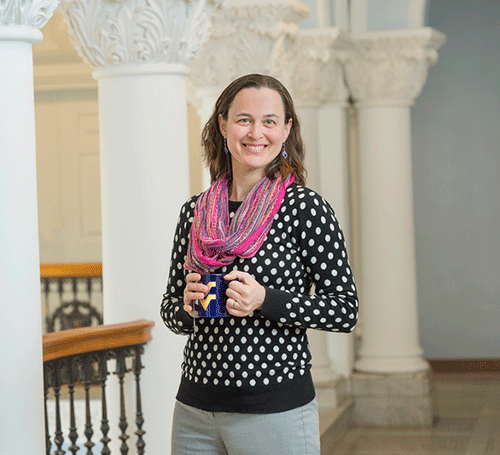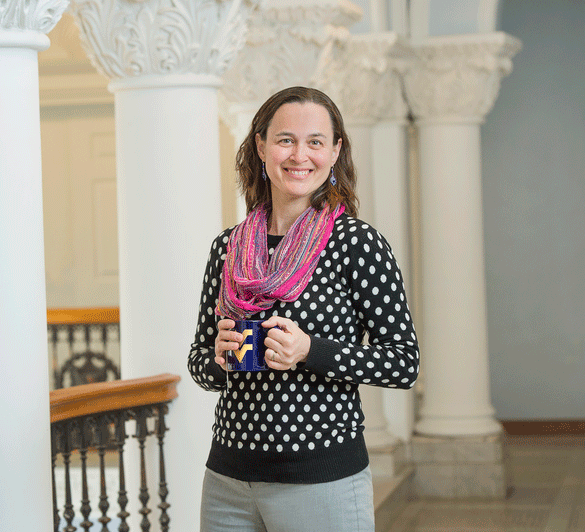Q&A: Catching a Gravitational Wave with a Pulsar’s Beam
Pulsars captivate Maura McLaughlin, a professor at West Virginia University. These highly magnetized neutron stars flash beams of electromagnetic radiation as they spin. And with masses equivalent to that of the Sun, but diameters seventy thousand times smaller, they are—besides black holes—the densest objects in the Universe. Astrophysicists still have many questions about pulsars, ranging from how they emit electromagnetic radiation to why they are so incredibly dense. But it’s exploiting the highly stable, periodic electromagnetic signals of pulsars to study gravitational waves that currently has McLaughlin hooked. In an interview with Physics, she explained where her fascination with pulsars came from, what gravitational-wave sources she hopes to detect, and why she recently visited Washington, D.C., to talk with members of Congress.
–Katherine Wright
With the 2015 detection of gravitational waves, it’s obviously an exciting time to work in astrophysics. But what initially drew you to the field and to pulsars?
The astrophysicist Alex Wolszczan. I met him in the early 90s while I was an undergrad at Penn State, and just after he had discovered the first extrasolar planets. These planets were orbiting a pulsar—lots of people don’t know that. I found this pulsar system fascinating and ended up working with Wolszczan one summer as a research assistant. I got to go to Puerto Rico to observe pulsars at the Arecibo Observatory, which is the biggest telescope in the world. The experience was really cool.
How do researchers detect gravitational waves with pulsars?
The collaboration that I’m part of—NANOGrav—is searching for changes in the travel time of the pulsar’s radio emission due to the passing of gravitational waves. When a gravitational wave passes between us and the pulsar, it stretches and squeezes spacetime, causing the pulse to arrive a bit earlier or later than it would in the absence of the wave. We time the arrival of pulsar signals for years to try to detect these small changes.
What gravitational-wave-producing events do you expect to detect with pulsars? Could you see the same events as LIGO did?
LIGO is sensitive to very short time-scale gravitational waves, on the order of milliseconds to seconds, while our experiment is sensitive to very long time-scale gravitational waves, on the order of years. We could never detect gravitational waves from two stellar-mass black holes merging—the time scale of the event is just too short. But we will be able to detect waves from black hole binaries in their inspiralling stage, when they’re still orbiting each other with periods of years. Also, our approach can only detect black holes that are much more massive that those LIGO observed. Our primary targets are supermassive black holes, even more massive than the one at the core of the Milky Way.
LIGO is basically probing the evolution and end products of stars, whereas our experiment is probing the evolution of galaxies and the cosmos. We'll be able to look way back in time at the processes by which galaxies formed through mergers.
The first detection of gravitational waves was front-page news. What impact has it had on your research?
I, and others in NANOGrav, got lots of condolences after LIGO’s detection, like “oh we’re sorry you weren't first.” But it’s been good for us. It has really spurred us on to make a detection. And it has made us more optimistic—if it worked for LIGO it should work for us, as our methods are rooted in the same principles. None of us doubted gravitational waves existed, but as far as funding agencies and the public go, LIGO’s detection makes a big difference. Now people can’t say, “Who knows if these things exist?” or “Who knows if these methods work?” LIGO’s detection has shown they do exist and the methods do work.
Apart from doubters, what other challenges do you face with your pulsar experiment?
Right now, our most significant challenge is that our radio telescopes are in danger of being shut down. Both Arecibo and the Green Bank Telescope (GBT) in West Virginia are suffering significant funding cuts. Many of our NANOGrav discussions lately are about what we can do to retain access to these telescopes. Losing one of these telescopes would reduce our experiment’s sensitivity by roughly half and increase the time to detection by at least several years. If we lose both, our project is dead in the water. Arecibo and GBT are currently the two most sensitive radio telescopes in the world. I think its crazy that they are possibly being shut down.
What are you doing to address the problem?
I recently spent two days on Capitol Hill in Washington, D.C., talking to senators and House representatives trying to make the case to keep GBT open. Most of the politicians actually agreed it should stay open; it’s just a matter of funding. Science in general just doesn't have enough funding.
How do you frame the issues when talking to politicians about science?
I try really hard to stress the opportunities for training students, the infrastructure, and the number of people who work at these telescopes. The technologies developed at the facilities are cutting edge and can be used for more than studying space. The science is incredibly interesting, but that in itself doesn’t always appeal to everybody.
With the current administration, arguments of US prominence are also really valuable. China is building a bigger telescope than Arecibo, and soon we won’t have the largest radio telescope in the world. Right now we are world leaders, but if the US wants to keeps its dominance then these telescopes have to remain open.
With the challenges you face, what would you say to someone thinking of joining this field?
Despite uncertainties with the telescopes, the future is bright. Now is a really good time to join the field: we’re going to make a detection any day now.
Know a physicist with a knack for explaining his or her research to others? Write to physics@aps.org. All interviews are edited for brevity and clarity.





